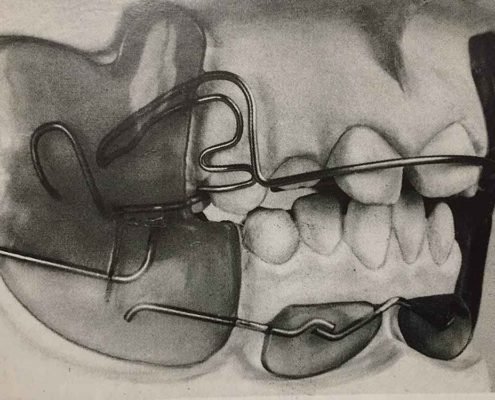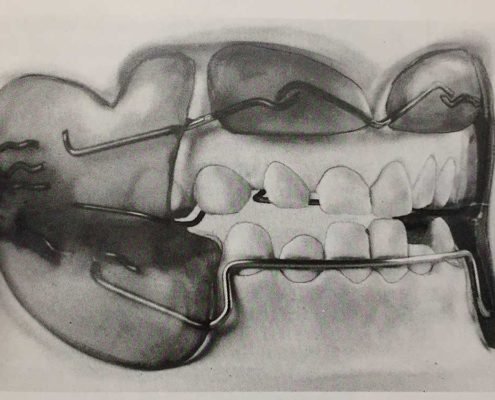The function regulator according to Fränkel is a so-called functional orthodontic appliance and is used for moving the bite where there is a retrusive occlusion (function regulator II) or protrusive occlusion (function regulator III) in the lower jaw. Fränkel I (lack of space) or Fränkel IV (open bite) weren’t used that much.
Among the countless removable braces with the working principle of the activator the function regulator has some unique properties, as it is constructed out of thin plastic shields in the vestibulum and wiring elements. The function regulator is thus anchored not only to the teeth, but partly to the soft tissues, i.e. lips and cheeks. The idea behind it was that the bite correction, thanks to the anchoring to the soft tissues, would be less caused by tooth movement, but mainly by influencing the jaw growth. However, this hypothesis did not stand up to the scientific review, because in fact the effects of the function regulator according to Fränkel hardly differ from other “functional orthodontic” appliances.
Rolf Fränkel, an all-around respected and extremely honest orthodontist and researcher, was one of the few great, old men of German orthodontics to take the trouble of learning English and presenting his studies regularly at European and American congresses.
At the same time, he set up his own scientific institute in Zwickau and tirelessly treated patients, researched and published his orthondontic hypothesis. His orthodontic activity, his activities as a teacher and researcher are all the more highly valued, as Fränkel resided in the former East Germany and did not receive the support of the local executives.

From the great period of functional orthodontics: Function regulator according to Fränkel IIThe study results he presented were remarkably good which can only be explained by the deliberate choice of particularly good cases, as Fränkel himself quite openly described in his textbooks. Only those patients were included in the studies who had a relaxed mouth closure after treatment, literally had an untreated competent lip seal at the end of retention or after treatment (in: Fränkel R, Fränkel C. Orofacial orthopedics with the function regulator, Karger, Basel 1989, pp. 165 and 200). It is no wonder to find good results, if only the successful treatment cases are included. Fränkel’s approach was certainly not deliberate falsification – otherwise he would not have described it openly – but quite customary in orthodontics until the sixties of the last century. The widespread overestimation of the function regulator’s effects is therefore simply due to the poor methodology of the studies at that time. For this reason, these results could not be reproduced in numerous subsequent studies by other authors. Overall, the function regulator is considered to share all disadvantages of the activator: it is a highly impairing, weakly effective device. The young patients who are treated with the function regulator know very well how to defend themselves by not wearing it as prescribed. Treatments with the function regulator can take two- to threefold the time of conventional orthodontic treatment duration without any special advantages. The function regulator therefore has to be regarded as obsolete and should no longer be used for children.
Under these circumstances, it’s all the more incomprehensible that in recent years, the actually only historically interesting function regulator has been dug up again – and not only from alternative medical side, but also from a South German university clinic for orthodontics. Even though Fränkel’s results could not be confirmed in dozens of studies by other authors, the university professor claims completely unimpressed that the function regulator leads to impressive skeletal changes. On what data he relies, remains his secret – probably it is only a late consequence of the great confusion that has left the myth and saga of functional orthodontics in German orthodontists’ heads.

Nevertheless: In order to give a positive impression of Frankel’s personality, it should be added, that in his older days he frankly admitted that he had treated only a part of his patients with the function regulator, if he had had today’s possibilities with fixed appliances. Other colleagues didn’t show this strong personality. They stuck to their dogmas and could not be convinced by scientific studies.
A tip for parents: Don’t accept treatment with the function regulator, because there’re appliances which are much more effective. Special mistrust is announced, if orthodontists want to sell the outdated function regulator as the latest trend of growth-influencing – there is, as we have shown above, no truth in it!
